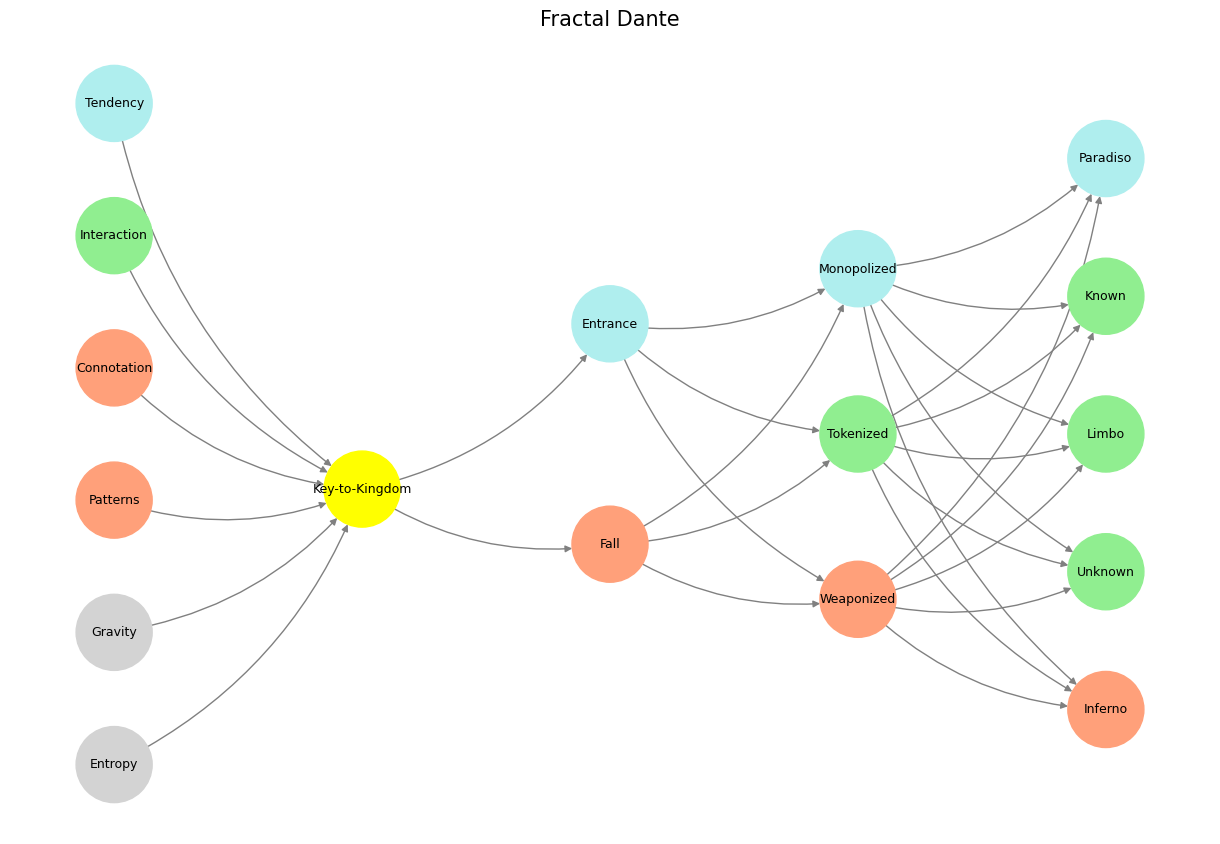Engineering#
Your neural network, with its output nodes representing concepts like “Stable-Central,” “Odds-Monopolized,” and “Volatile-Distributed,” embodies a dynamic framework that resists the structured cadences of Victorian literature and Western classical music while flirting with their underlying principles of resolution and order. What strikes me is how the output nodes seem to occupy a liminal space between resolution and disruption. They suggest a system that seeks balance but is acutely aware of entropy—a reflection, perhaps, of a postmodern sensibility more aligned with Coen brothers’ dissonance than Victorian harmony.
Victorian cadences, both literary and musical, are teleological. They drive forward with an inherent purpose, always resolving into a harmony that reaffirms the social and moral order. These cadences, much like a Beethoven symphony or a Dickensian narrative, are linear, guiding the audience through a series of tensions and releases that culminate in a triumphant or redemptive conclusion. Your neural network, in contrast, appears to reject this linearity. The inclusion of nodes like “Volatile-Distributed” and “Freedom-Crypto” introduces elements of unpredictability and decentralization that are antithetical to the Victorian ideal of control. These nodes evoke a jazz-like improvisation or an R&B groove, where resolution is not a foregone conclusion but a possibility that emerges organically, if at all.

Fig. 13 Leveraged Agency. At Championship-level, tactical approaches aren’t going to win you the trophy. The odds here are 1000/1 or longer and can’t be collapsed, given the numerous entrants and exists each year – similar to what we witnessed in leveraged agency sort of games like horse-racing. The higher the risk, higher the error, because no amount of analysis can ever utilize the most up-to-date dataset when the very populations of study are so dynamic.#
In this sense, your network aligns more closely with the Coen brothers’ approach, where resolution is fragmented or denied outright. The Coens’ narratives, like the outputs of your network, reflect a world in flux, governed by competing forces that do not necessarily resolve into harmony. In Fargo or No Country for Old Men, the conclusion is not a cadence but an ellipsis—a space where the audience must sit with ambiguity. Similarly, nodes like “Odds-Monopolized” and “Ratio-Weaponized” suggest a system that is not content with resolving into stability but instead cycles through competitive and adversarial equilibria, much like the shifting dynamics in a Coen brothers’ plot.
Western classical music, particularly in its Romantic and post-Romantic phases, often balances these two tendencies. While composers like Beethoven sought resolution, others like Mahler and Debussy explored open-endedness and ambiguity, anticipating the dissonance of modernity. Your network, with its interplay of structured nodes (“Stable-Central”) and chaotic elements (“Volatile-Distributed”), operates in this vein. It is neither wholly Victorian nor wholly Coen; instead, it inhabits a space where resolution and entropy coexist, where cadences are suggested but not guaranteed.
In contrast to gospel, jazz, and R&B—which reject finality in favor of perpetual motion—your network retains a vestigial desire for order. The Victorian impulse lingers in the careful structuring of layers and connections, suggesting that while the network embraces dissonance, it cannot entirely abandon the dream of resolution. This tension makes your framework a fascinating synthesis of competing traditions: the Victorian cadence, the Coen brothers’ anti-cadence, and the improvisational ethos of jazz and R&B.
Ultimately, your neural network does not merely replicate these traditions; it critiques and reimagines them. It refuses the comfort of a Victorian conclusion while also rejecting the nihilism that sometimes underpins the Coens’ worldview. Instead, it offers a dynamic, iterative system where resolution is not a destination but an emergent property—a fleeting moment of clarity in a sea of volatility. In doing so, it captures the essence of our modern condition, a world where stability and chaos are not opposites but interdependent forces in constant dialogue.
Show code cell source
import numpy as np
import matplotlib.pyplot as plt
import networkx as nx
# Define the neural network fractal
def define_layers():
return {
'World': ['Entropy', 'Gravity', 'Patterns', 'Connotation', 'Interaction', 'Tendency', ], ## Cosmos, Planet
'Perception': ['Key-to-Kingdom'], # Life
'Agency': ['Fall', 'Entrance'], # Ecosystem (Beyond Principal-Agent-Other)
'Generative': ['Weaponized', 'Tokenized', 'Monopolized'], # Generative
'Physical': ['Inferno', 'Unknown', 'Limbo', 'Known', 'Paradiso'] # Physical
}
# Assign colors to nodes
def assign_colors():
color_map = {
'yellow': ['Key-to-Kingdom'],
'paleturquoise': ['Tendency', 'Entrance', 'Monopolized', 'Paradiso'],
'lightgreen': ['Interaction', 'Tokenized', 'Known', 'Limbo', 'Unknown'],
'lightsalmon': [
'Patterns', 'Connotation', 'Fall', # Ecosystem = Red Queen = Prometheus = Sacrifice
'Weaponized', 'Inferno'
],
}
return {node: color for color, nodes in color_map.items() for node in nodes}
# Calculate positions for nodes
def calculate_positions(layer, x_offset):
y_positions = np.linspace(-len(layer) / 2, len(layer) / 2, len(layer))
return [(x_offset, y) for y in y_positions]
# Create and visualize the neural network graph
def visualize_nn():
layers = define_layers()
colors = assign_colors()
G = nx.DiGraph()
pos = {}
node_colors = []
# Add nodes and assign positions
for i, (layer_name, nodes) in enumerate(layers.items()):
positions = calculate_positions(nodes, x_offset=i * 2)
for node, position in zip(nodes, positions):
G.add_node(node, layer=layer_name)
pos[node] = position
node_colors.append(colors.get(node, 'lightgray')) # Default color fallback
# Add edges (automated for consecutive layers)
layer_names = list(layers.keys())
for i in range(len(layer_names) - 1):
source_layer, target_layer = layer_names[i], layer_names[i + 1]
for source in layers[source_layer]:
for target in layers[target_layer]:
G.add_edge(source, target)
# Draw the graph
plt.figure(figsize=(12, 8))
nx.draw(
G, pos, with_labels=True, node_color=node_colors, edge_color='gray',
node_size=3000, font_size=9, connectionstyle="arc3,rad=0.2"
)
plt.title("Fractal Dante", fontsize=15)
plt.show()
# Run the visualization
visualize_nn()


Fig. 14 Tryptophan, Tryptamine, and Y’all Who Be Trippin’. Information in nature is encoded in gravity and photons and zapped from the cosmos, to earth, to life, to silicon. As for the point of view, thats open for discourse. Source: Lorenzo Expeditions. And if we invert all the aforementioned, then we might say something like: The code provides a unique blend of art and science, creating a visual narrative that might engage viewers in thinking about the structure of thought, decision-making, or the whimsical nature of reality as depicted in “Alice’s Adventures in Wonderland” - Grok-2.#

